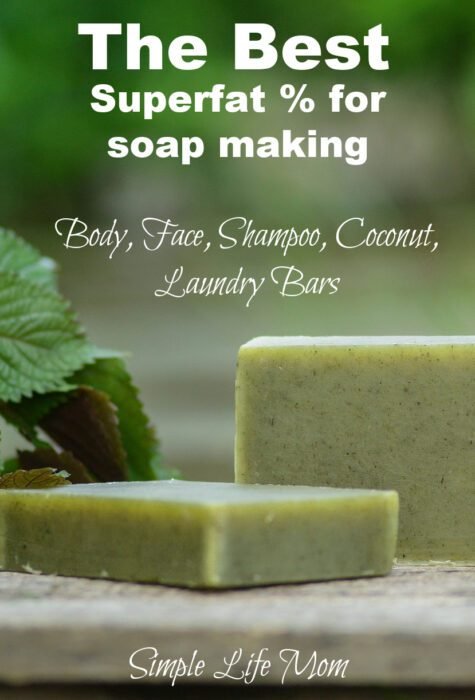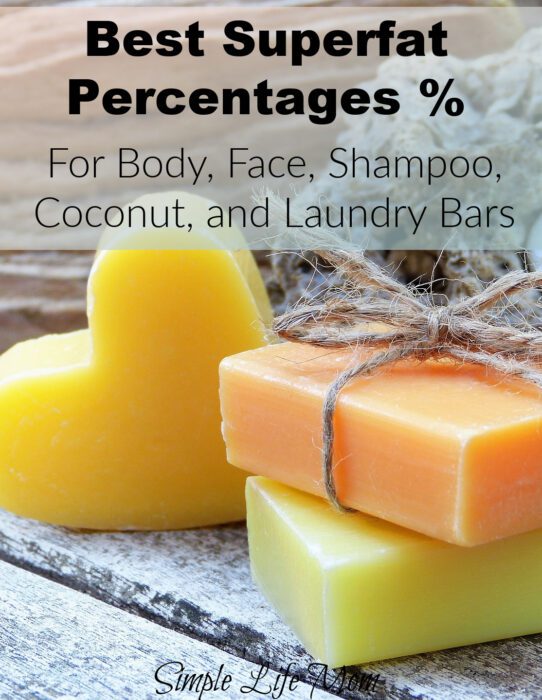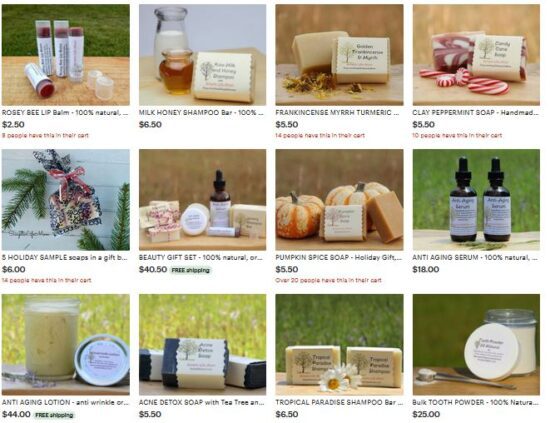I get a lot of questions about creating soap and shampoo bar recipes. One of the questions I get the most is about superfat content; what’s the best superfat percentage for soap body bars, face bars, or shampoo bars and why?
I’m sure there are a lot of strong opinions about the best percentages to superfat soap and shampoo. There will definitely be differences depending on hair type, skin needs, or simply just based on what you’ve used in the past and what you like.
I’ve done research into what the percentages are for different types of soap bars, but I also base my information on experience.

For example, I started shampoo bars with a higher percentage of superfat because of my thick, wavy hair that tends toward frizziness. Since then, I’ve discovered that milk and honey are a much better solution.
I made laundry soap with 10% superfat, only to realize that it gums up my washer and needed to be more toward 1-2%.
All this to say, experience can be a great thing. From reading and a whole lot of trial and error, I have formed some opinions and what’s best. I’m not a “My way or the highway” kind of person (like some people) though, and understand that there is some give and take in these numbers, so keep that in mind.
What is Superfat?
When soap is made from scratch, you work with oils, lye, and water. These come together to make a chemical reaction that creates soap. If you do not use lye, you will have oil and water. People who want to make soap without lye need to understand how necessary it is.
Soap recipes are made with “too much” oil. This excess oil means that when the chemical reaction is finished, all of lye is broken apart and combined with oil to make a new molecule: soap! No lye is leftover.
We are 100% certain that there is no lye leftover in the soap, because of superfatting.
It takes a particular amount of lye to convert each type of oil to soap. This is carefully calculated (by hand, but mostly by lye calculators these days). The small amount of oil that is leftover making the soap or shampoo bar moisturizing, as well as insuring that no lye is leftover in the product, is called the superfatting percentage or discounting lye.
If a soap bar has 5% superfat, then 5% of the oils in the recipe are leftover after the saponification process is done. If the shampoo bar says 10% superfat, then 10% of oils are leftover, etc.
Superfat Percentage for Soap Bars
Everyone has their favorite percentage for body bars.
Mine is 5%. The bars are hydrating, without leaving a film over the body. If you are looking for more moisture, then change the recipe to 10% or even 15%.
I, typically, do not go below 5% and don’t go above 10% for a body bar. Again, this will vary based on someone’s practice and the rest of the recipe. If the recipe is very cleansing with very little moisture (olive oil or coconut oil bars) then I would go higher. More on that below.
Learn more and get recipes here.

Superfat Percentage for Face Bars
Face bars that cleanse, but don’t leave the sensitive skin on the face too dry are typically made at 10-15% superfat. I’ve found this to be a good balance between cleansing and hydrating.
Again, what is in the recipe? Are moisturizing oils used, or very cleansing oils, or a balance? This will all effect the superfat amount.
Superfat Percentage for Shampoo Bars
I used to think a higher superfat content was best. After all, I have thick, dry, out of control hair when using 5%. Through research and trial and error I have discovered ingredients that help balance oils (nettle, jojoba) and ingredients that hydrate and defrizz (beeswax, honey, jojoba, milks).
I make shampoo bars typically at 5-10%, depending on their purpose and ingredients. Too many oils will weigh down hair, but usually the weight is brought about by minerals in hard water, not the superfat content of the shampoo bar.
If you have hard water, you can use a shower filter to help. I definitely recommend using a conditioner though:
- I have conditioner bar recipes here.
- You can also make a conditioner spray (my favorite)
- You can buy conditioner sprays in my shop.
Superfat Percentage for Laundry Bars
Laundry bars must be made in a specific way. A simple recipe is best.
The most important thing to keep in mind that a superfat of 1-2% is necessary. Anything above this small percentage will cause the soap to build up in your washing machine and cause problems.
Make a laundry bar at 1-2% superfat, and grate it into a mixture of 1:1 borax and washing powder. There is a combined effort to change the pH to cause dirt to release from clothing and clean clothes.
Baking soda cause irritation in natural deodorants? Then skip the borax and washing powder and melt the soap in water (2 four ounce bars to 1 gallon of water). Use 1/2 cup per load.
Superfat Percentage for Coconut Soap Bars
You’ll hear all kinds of things if you search coconut bars on the internet. Coconut bars are fabulous! But you do need to change the superfat content. I make salt soap recipes that have 80% coconut oil. These are wonderfully moisturizing. Some of the best bars you can get! But how is that possible with so much salt and coconut oil? Superfatting! These bars need 20% superfatting.
I find 20% superfatting with 70-80% coconut oil ideal. I don’t go above 80% coconut oil. The bars tend to not have the bubbles and nice soap quality when I go over that. The other 20-30% oils in the recipe should be chosen to create bubbles and moisturize. You can learn more here.
What have I missed? If you have a question or have a different experience, leave a reply. I’d love to hear your comments and help if I can.






1 Comment
Leave your reply.